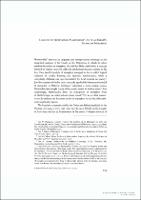Please use this identifier to cite or link to this item:
https://hdl.handle.net/20.500.12202/6141Full metadata record
| DC Field | Value | Language |
|---|---|---|
| dc.contributor.author | Cohen, Mordechai Z. | - |
| dc.date.accessioned | 2020-09-21T20:38:51Z | - |
| dc.date.available | 2020-09-21T20:38:51Z | - |
| dc.date.issued | 2002 | - |
| dc.identifier.citation | Cohen, Mordechai Z. “Logic to Interpretation: Maimonides’ Use of Al-Farabi’s Model of Metaphor,” Zutot: Perspectives on Jewish Culture 2.1 (2002): 104–113. | en_US |
| dc.identifier.issn | 1875-0214 ; 1571-7283 | - |
| dc.identifier.uri | https://doi.org/10.1163/187502102788638905 | en_US |
| dc.identifier.uri | https://hdl.handle.net/20.500.12202/6141 | - |
| dc.description | Scholarly article | en_US |
| dc.description.abstract | Maimonides' interests in language and interpretation converge in the exegetical sections of his Guide of the Perplexed, in which he often invokes the notion of metaphor (Ar. isti"ara; Hebr. hash'alah), a concept defined in various ways by different intellectual streams current in his day. Two parallel models of metaphor emerged in the so-called logical tradition of Arabic learning and Quranic hermeneutics, while a completely different one was formulated by Arab experts on poetry.' Jewish exegetes in Muslim lands naturally applied the hermeneutic model of metaphor to Hebrew Scripture.2 Adopting a more unique stance, Moses ibn Ezra sought traces of the poetic model in biblical verse.3 Not surprisingly, Maimonides drew his conception of metaphor from al-Farabi's logic, as earlier scholars have noted.4 Yet, as we shall demonstrate, he tailored the Farabian model of metaphor to suit his philosophical exegetical program. (from Introduction) | en_US |
| dc.language.iso | en_US | en_US |
| dc.publisher | Dordrecht ; Boston : Kluwer Academic Publishers, c2002- ; Brill | en_US |
| dc.relation.ispartofseries | Zutot: Perspectives on Jewish Culture;2(1) | - |
| dc.rights | Attribution-NonCommercial-NoDerivs 3.0 United States | * |
| dc.rights.uri | http://creativecommons.org/licenses/by-nc-nd/3.0/us/ | * |
| dc.subject | Maimonides | en_US |
| dc.subject | Al-Farabi | en_US |
| dc.subject | model of metaphor | en_US |
| dc.subject | biblical hermeneutics | en_US |
| dc.title | Logic to Interpretation: Maimonides' Use of al-Fârâbî's Model of Metaphor. | en_US |
| dc.type | Article | en_US |
| dc.contributor.orcid | https://orcid.org/0000-0003-1621-6116 | |
| local.yu.facultypage | https://www.yu.edu/faculty/pages/cohen-mordechai | |
| Appears in Collections: | Bernard Revel Graduate School of Jewish Studies (BRGS): Faculty Publications | |
Files in This Item:
| File | Description | Size | Format | |
|---|---|---|---|---|
| CohenM [18750214 - Zutot] Logic to Interpretation Maimonides' Use of al-Fârâbî's Model of Metaphor.pdf | 2.06 MB | Adobe PDF |  View/Open |
This item is licensed under a Creative Commons License

